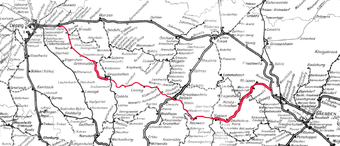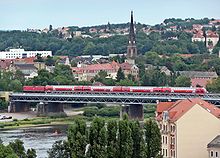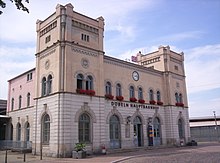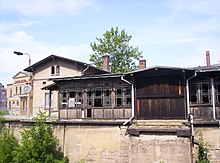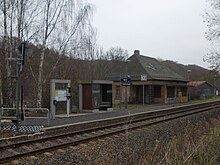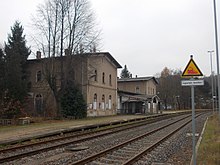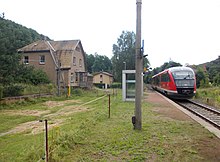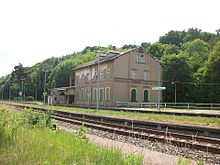Borsdorf – Coswig railway line
| Borsdorf (Sachs) –Coswig Abzw B | |||||||||||||||||||||||||||||||||||||||||||||||||||||||||||||||||||||||||||||||||||||||||||||||||||||||||||||||||||||||||||||||||||||||||||||||||||||||||||||||||||||||||||||||||||||||||||||||||||||||||||||||||||||||||||||||||||||||||||||||||||||||||||||||||||||||||||||||||||||||||||||||||||||||||||||||||||||||||||||||||||||||||||||||||||||||||||||||||||||||||||||||||||||||||||||||||
|---|---|---|---|---|---|---|---|---|---|---|---|---|---|---|---|---|---|---|---|---|---|---|---|---|---|---|---|---|---|---|---|---|---|---|---|---|---|---|---|---|---|---|---|---|---|---|---|---|---|---|---|---|---|---|---|---|---|---|---|---|---|---|---|---|---|---|---|---|---|---|---|---|---|---|---|---|---|---|---|---|---|---|---|---|---|---|---|---|---|---|---|---|---|---|---|---|---|---|---|---|---|---|---|---|---|---|---|---|---|---|---|---|---|---|---|---|---|---|---|---|---|---|---|---|---|---|---|---|---|---|---|---|---|---|---|---|---|---|---|---|---|---|---|---|---|---|---|---|---|---|---|---|---|---|---|---|---|---|---|---|---|---|---|---|---|---|---|---|---|---|---|---|---|---|---|---|---|---|---|---|---|---|---|---|---|---|---|---|---|---|---|---|---|---|---|---|---|---|---|---|---|---|---|---|---|---|---|---|---|---|---|---|---|---|---|---|---|---|---|---|---|---|---|---|---|---|---|---|---|---|---|---|---|---|---|---|---|---|---|---|---|---|---|---|---|---|---|---|---|---|---|---|---|---|---|---|---|---|---|---|---|---|---|---|---|---|---|---|---|---|---|---|---|---|---|---|---|---|---|---|---|---|---|---|---|---|---|---|---|---|---|---|---|---|---|---|---|---|---|---|---|---|---|---|---|---|---|---|---|---|---|---|---|---|---|---|---|---|---|---|---|---|---|---|---|---|---|---|---|---|---|---|---|---|---|---|---|---|---|---|---|---|---|---|---|---|---|---|---|---|---|---|---|---|---|---|---|---|---|---|---|---|---|---|---|---|---|---|---|---|---|---|---|---|---|---|---|---|---|---|---|---|---|---|---|
|
Excerpt from the route map of Saxony 1902
| |||||||||||||||||||||||||||||||||||||||||||||||||||||||||||||||||||||||||||||||||||||||||||||||||||||||||||||||||||||||||||||||||||||||||||||||||||||||||||||||||||||||||||||||||||||||||||||||||||||||||||||||||||||||||||||||||||||||||||||||||||||||||||||||||||||||||||||||||||||||||||||||||||||||||||||||||||||||||||||||||||||||||||||||||||||||||||||||||||||||||||||||||||||||||||||||||
| Route number : | 6386; sä. BC | ||||||||||||||||||||||||||||||||||||||||||||||||||||||||||||||||||||||||||||||||||||||||||||||||||||||||||||||||||||||||||||||||||||||||||||||||||||||||||||||||||||||||||||||||||||||||||||||||||||||||||||||||||||||||||||||||||||||||||||||||||||||||||||||||||||||||||||||||||||||||||||||||||||||||||||||||||||||||||||||||||||||||||||||||||||||||||||||||||||||||||||||||||||||||||||||||
| Course book section (DB) : | 241.1, 506 | ||||||||||||||||||||||||||||||||||||||||||||||||||||||||||||||||||||||||||||||||||||||||||||||||||||||||||||||||||||||||||||||||||||||||||||||||||||||||||||||||||||||||||||||||||||||||||||||||||||||||||||||||||||||||||||||||||||||||||||||||||||||||||||||||||||||||||||||||||||||||||||||||||||||||||||||||||||||||||||||||||||||||||||||||||||||||||||||||||||||||||||||||||||||||||||||||
| Route length: | 102.649 km | ||||||||||||||||||||||||||||||||||||||||||||||||||||||||||||||||||||||||||||||||||||||||||||||||||||||||||||||||||||||||||||||||||||||||||||||||||||||||||||||||||||||||||||||||||||||||||||||||||||||||||||||||||||||||||||||||||||||||||||||||||||||||||||||||||||||||||||||||||||||||||||||||||||||||||||||||||||||||||||||||||||||||||||||||||||||||||||||||||||||||||||||||||||||||||||||||
| Gauge : | 1435 mm ( standard gauge ) | ||||||||||||||||||||||||||||||||||||||||||||||||||||||||||||||||||||||||||||||||||||||||||||||||||||||||||||||||||||||||||||||||||||||||||||||||||||||||||||||||||||||||||||||||||||||||||||||||||||||||||||||||||||||||||||||||||||||||||||||||||||||||||||||||||||||||||||||||||||||||||||||||||||||||||||||||||||||||||||||||||||||||||||||||||||||||||||||||||||||||||||||||||||||||||||||||
| Route class : | D4 | ||||||||||||||||||||||||||||||||||||||||||||||||||||||||||||||||||||||||||||||||||||||||||||||||||||||||||||||||||||||||||||||||||||||||||||||||||||||||||||||||||||||||||||||||||||||||||||||||||||||||||||||||||||||||||||||||||||||||||||||||||||||||||||||||||||||||||||||||||||||||||||||||||||||||||||||||||||||||||||||||||||||||||||||||||||||||||||||||||||||||||||||||||||||||||||||||
| Power system : |
Meißen-Triebischtal – Coswig 15 kV 16.7 Hz ~ |
||||||||||||||||||||||||||||||||||||||||||||||||||||||||||||||||||||||||||||||||||||||||||||||||||||||||||||||||||||||||||||||||||||||||||||||||||||||||||||||||||||||||||||||||||||||||||||||||||||||||||||||||||||||||||||||||||||||||||||||||||||||||||||||||||||||||||||||||||||||||||||||||||||||||||||||||||||||||||||||||||||||||||||||||||||||||||||||||||||||||||||||||||||||||||||||||
| Maximum slope : | 11 ‰ | ||||||||||||||||||||||||||||||||||||||||||||||||||||||||||||||||||||||||||||||||||||||||||||||||||||||||||||||||||||||||||||||||||||||||||||||||||||||||||||||||||||||||||||||||||||||||||||||||||||||||||||||||||||||||||||||||||||||||||||||||||||||||||||||||||||||||||||||||||||||||||||||||||||||||||||||||||||||||||||||||||||||||||||||||||||||||||||||||||||||||||||||||||||||||||||||||
| Minimum radius : | 285 m | ||||||||||||||||||||||||||||||||||||||||||||||||||||||||||||||||||||||||||||||||||||||||||||||||||||||||||||||||||||||||||||||||||||||||||||||||||||||||||||||||||||||||||||||||||||||||||||||||||||||||||||||||||||||||||||||||||||||||||||||||||||||||||||||||||||||||||||||||||||||||||||||||||||||||||||||||||||||||||||||||||||||||||||||||||||||||||||||||||||||||||||||||||||||||||||||||
| Top speed: | 100 km / h | ||||||||||||||||||||||||||||||||||||||||||||||||||||||||||||||||||||||||||||||||||||||||||||||||||||||||||||||||||||||||||||||||||||||||||||||||||||||||||||||||||||||||||||||||||||||||||||||||||||||||||||||||||||||||||||||||||||||||||||||||||||||||||||||||||||||||||||||||||||||||||||||||||||||||||||||||||||||||||||||||||||||||||||||||||||||||||||||||||||||||||||||||||||||||||||||||
| Dual track : | Meißen old town – Coswig Abzw B | ||||||||||||||||||||||||||||||||||||||||||||||||||||||||||||||||||||||||||||||||||||||||||||||||||||||||||||||||||||||||||||||||||||||||||||||||||||||||||||||||||||||||||||||||||||||||||||||||||||||||||||||||||||||||||||||||||||||||||||||||||||||||||||||||||||||||||||||||||||||||||||||||||||||||||||||||||||||||||||||||||||||||||||||||||||||||||||||||||||||||||||||||||||||||||||||||
|
|||||||||||||||||||||||||||||||||||||||||||||||||||||||||||||||||||||||||||||||||||||||||||||||||||||||||||||||||||||||||||||||||||||||||||||||||||||||||||||||||||||||||||||||||||||||||||||||||||||||||||||||||||||||||||||||||||||||||||||||||||||||||||||||||||||||||||||||||||||||||||||||||||||||||||||||||||||||||||||||||||||||||||||||||||||||||||||||||||||||||||||||||||||||||||||||||
The Borsdorf – Coswig railway is a main line in Saxony that was originally built and operated by the Leipzig-Dresden Railway Company . It runs largely along the Freiberg Mulde from Borsdorf via Döbeln and Meißen to Coswig near Dresden . It was part of a long-distance connection from Leipzig to Dresden, but is now only used for freight traffic and in sections for local rail transport.
history
1860-1945
Since December 1, 1860, Meissen had a connection to the Leipzig-Dresden Railway through a branch line from Coswig. On July 7, 1864, the Leipzig-Dresden Railway Company applied for the construction of a second railway connection between Leipzig and Dresden. A route was planned along the Freiberg Mulde via Döbeln to Meißen in order to merge there with the existing branch line from Coswig. On January 16, 1866, the concession to build the line was granted, and work began on August 4, 1865 near Borsdorf. Opening dates:
- May 14, 1866: Borsdorf – Grimma
- October 27, 1867: Grimma – Leisnig
- June 2, 1868: Leisnig – Döbeln
- October 25, 1868: Döbeln – Nossen
- December 22nd, 1868: Nossen – Meißen
On July 1, 1876, the Leipzig-Dresden Railway Company was nationalized and the line was henceforth part of the network of the Royal Saxon State Railways . Between 1898 and 1909 the Borsdorf – Großbothen and Döbeln – Coswig sections were expanded to two tracks. The construction of the second track between Großbothen and Döbeln was also started later. Because of the Second World War , however, only the Großbothen– Tanndorf section was completed in 1939 .
One of the largest new construction projects in the interwar period was the renewal of the Elbe bridge in Meißen . Between 1925 and 1926 Lauchhammer-Rheinmetall AG erected two new steel framework superstructures there. The bridge was blown up at the end of World War II in 1945, but was soon rebuilt in its old form. From 1946 to 2013 there was only one track left on the bridge.
GDR time
After the Second World War a railway track was in the context of reparations for the Soviet Union dismantled. Because the second track on the Leipzig – Dresden railway line between Borsdorf and Coswig was also dismantled, a system called ring traffic was set up using both lines. In particular, through freight trains used the main route via Riesa in the direction of Dresden and the route via Döbeln and Meißen in the direction of Leipzig. Because of the lower line speed due to the narrow arches in the valleys, high-speed passenger trains were only included in the ring traffic in exceptional cases. Ring traffic ended in 1971 after the Leipzig – Dresden line had been continuously expanded to double-track and additionally electrified.
In 1970 the section Meißen Triebischtal –Coswig used for suburban traffic in Dresden was electrified. Electric trains began operating there on December 18, 1970. A little later - in September 1973 - the line section was included in the network of the newly created Dresden S-Bahn . From then on, all passenger train routes in Meißen were broken, where it was now necessary to change between the trains on the Leipzig – Meißen and Meißen Triebischtal – Dresden routes. Even the two pairs of express trains running on the route now only ran between Leipzig and Meißen. In some timetable periods, the express trains did not run at all.
In December 1981 the second track between Meißen and Coswig was put back into operation. In 1989 the short section Borsdorf – Beucha was also given an electrical contact line. Electrical operation began there on September 30, 1989. The planned extension of the overhead contact line towards Großbothen was prepared by installing an additional catenary length between the electrical station boundary on the southern end of the Beucha station and the motorway bridge of today's A 14. It would have been possible without shutdowns in Beucha station. Due to the lack of use and because the Beucha station was to be fundamentally rebuilt with changes to the track layout, the chain plant was dismantled in mid-2011. The catenary masts were retained, so that a new construction of the catenary remains possible.
Since 1990
A completely new situation arose after the political change in East Germany in 1989/90. For the first time in decades, end-to-end express trains ran again between Leipzig and Dresden via Döbeln. Together with the two-hour local trains Leipzig – Meißen there was an hourly travel offer. The Dresden S-Bahn - now known as the S1 line (Meißen-Triebischtal - Dresden - Schöna) - has been running every half hour since then. In 2000, after the establishment of the Upper Elbe Transport Association and the Association for the Local Transport Area Leipzig (ZVNL) , this service concept was abandoned. The last express trains between Leipzig and Zittau were canceled on June 9, 2001.
During the flood in August 2002 , the route between Großbothen and Coswig was interrupted at several points. The most serious was the damage between Tanndorf and Leisnig. In addition to several smaller damaged areas, around 500 meters of the route including the embankment were completely destroyed near Tanndorf. As of August 21, 2004, the route could be used continuously again. According to a city council, the federal government invested 45 million euros in the route after the floods in 2002 .
Until December 2015, the offer consisted of a two-hour service with regional trains between Leipzig and Meißen, which was condensed to Döbeln Hbf in the morning and in the afternoon during rush hour. Outside of rush hour and on weekends, the hourly service ended in Grimma. Siemens Desiro Classic railcars were in use until June 2016, also in double traction at peak times. Other trains ran on weekday mornings and late afternoons in an alternating cycle between Leipzig and Grimma. The symmetry time of the timetable between Leipzig and Nossen was about three minutes earlier than usual, which means that the transfer times in the direction and the opposite direction z. B. in Leipzig deviated up to eight minutes. The importance of the route has decreased significantly in freight transport. This is essentially limited to the operation of the Rhäsa tank farm on the former route to Riesa .
On May 2nd, 2010 the first construction phase of the electronic interlocking (ESTW) Muldental with the ESTW-A Großbothen and ESTW-A Leisnig was put into operation. It is controlled from the sub-center in Geithain, which has been converted into ESTW-Z . At the end of July 2012, the connection of the Großsteinberg and Grimma Oberer Bahnhof stations to the Muldental ESTW was completed. The Naunhof station was included in the Muldental ESTW after the construction of a second outer platform in autumn 2013 at the end of November of the same year. On August 9, 2015, Borsdorf – Naunhof with the converted Beucha station was included in the ESTW as the last section of the route.
Since autumn 2010, the Oberelbe Transport Association (VVO) has been considering the permanent cessation of local rail transport between Nossen and Meißen-Triebischtal. In 2010 a citizens' initiative collected 14,000 signatures to keep the route. According to a citizens' initiative, more than 1000 passengers per day were counted in 2001; At the beginning of 2014 there were still 400. In between, the direct connections to Dresden and the hourly frequency have been thinned out to two-hourly intervals.
On June 3, 2013, the train service between Großbothen and Meißen had to be stopped due to a flood . After the damage had been repaired, train traffic between Döbeln and Meißen-Triebischtal was resumed on June 8, 2013.
In 2013, the section used by the Dresden S-Bahn was expanded, for which the route between Meißen Triebischtal and Meißen was completely closed. The new Meißen Altstadt stop was built near Meißen city center, and the second track was rebuilt in the section between Meißen Altstadt and Meißen. After the work was completed, the S1 line has been running continuously to and from Meißen-Triebischtal again since November 30, 2013.
From November 2013 to mid-2014, the route between Großbothen and Leisnig was interrupted for the renovation of the viaduct over the Mulde near Kösser. There was replacement rail traffic on the affected section.
On November 28, 2013, the members of the Verkehrsverbund Oberelbe (VVO) decided, for economic reasons, to stop train traffic on route 110 between Meißen and Nossen from December 2015 and to replace it with buses. With an average of 13 passengers per train, the section between Nossen and Meißen was one of the least in demand in the VVO area; since 2012 the number of passengers has continued to decline. By replacing the trains with an “optimized bus network”, it was hoped that the subsidy requirement would be significantly reduced. The VVO put the cost of maintaining traffic at 1.6 million euros per year. A researched expansion of the rail service would have doubled the number of passengers and tripled the need for subsidies.
On March 7, 2014, the Central Saxony Transport Association decided not to order any more trains between Döbeln and Nossen from December 2015. Most recently, 200 to 300 passengers per day used the trains. The association also decided to set up a new, central stop on Döbelner Körnerplatz. A citizens' initiative had collected 7,000 signatures against the closure plans by March 2014.
On December 12, 2015, with the last scheduled train of the RB 110 on the Meißen Triebischtal – Döbeln section, local rail traffic ended. The association for the local traffic area Leipzig (ZVNL) wants to continue to order services of the local rail passenger traffic between Leipzig and Döbeln. On September 17, 2015, the ZVNL also published a change to the tender for the North West Saxony diesel network / Part B , which was supposed to ensure the transport services from June 12, 2016 to December 13, 2025 again spatially up to the Döbeln-Zentrum stop . In 2015, politicians and citizens campaigned in a position paper for the simultaneous extension of passenger traffic to Roßwein instead of to Döbeln-Zentrum , as this would be possible in terms of the planned timetable . The efforts to resume the local rail transport between Döbeln Hauptbahnhof and Döbeln-Zentrum (or even beyond) have so far been unsuccessful.
On June 12, 2016, Transdev Regio Ost took over operations between Leipzig and Döbeln under the brand name "Mitteldeutsche Regiobahn".
After a year of new "Busnetz Nossen", the Upper Elbe Transport Association drew a positive balance in March 2017. In contrast to the discontinued rail connection, which most recently carried around 70,000 passengers per year, the five newly established or reinforced bus routes counted over 500,000 passengers in 2016, 115,500 more than in the previous year. For the VVO, the subsidy requirement for the provision of transport services fell by half to 740,000 euros. It should be noted with regard to the figures that, due to the transfer in Nossen, the passengers are recorded individually for each line and therefore twice, in contrast to the earlier rail traffic.
Döbeln - Meißen: New infrastructure operator
On June 28, 2013, DB Netz AG published an offer to sell the 37.1-kilometer section between Döbeln (exclusively), Nossen and Meißen-Triebischtal (exclusively) because of inefficiency. According to this information, annual income from the infrastructure of around 1.3 million euros would be offset by costs for maintaining the line of around 2.3 million euros (of which around 1.4 million for staff and 0.8 million for maintenance). In addition, investments of around 24.8 million euros are due in the years 2014 to 2018. The purchase price was quoted at 627,990 euros (net), the annual rent at 50,239 euros. DB Netz then decided in mid-2015 to hand over this section of the route to Nossen-Riesaer Eisenbahn-Compagnie GmbH (NRE) as the railway infrastructure company . The company was previously the leaseholder of the Nossen – Riesa line with the connection to the Neubodenbach tank farm.
The handover, originally planned for December 13, 2015, was delayed until April 16, 2016, after a first delay to February 2016 had been announced in 2015. The NRE operates the Miltitz-Roitzschen-Roßwein section in the train control mode . The train journeys are always accompanied by an NRE employee in the car who operates the local crossing safety systems.
outlook
(Leipzig -) Borsdorf - Döbeln: electrification and S-Bahn integration
In the 1980s, it was planned to integrate Grimmas into what was then the Leipzig S-Bahn network . The construction of the catenary between Borsdorf and Beucha was an advance payment. However, further electrification failed because the bridge on federal motorway 14 was too low . Since the A 14 was expanded in 2009 and the bridge is now higher, the option was considered again in 2012. The Saxon Minister of Economic Affairs at the time, Sven Morlok , stated on the occasion of the commissioning of the S-Bahn network that the integration was not expected before 2025.
The coal phase-out law passed in summer 2020 provides for a feasibility study on electrification for the Borsdorf - Grimma (- Döbeln) section.
Döbeln - Coswig (- Dresden): Reactivation efforts
On November 13th, 2018 the Verkehrsverbund Oberelbe decided at its association meeting that a resumption of local rail transport between Döbeln and Meißen would be "actively and constructively" supported. The background to the change of heart is the plans of the Free State of Saxony to provide additional funds for the development of local public transport in rural areas.
For the local rail passenger transport between Döbeln and Meißen, funds of two million euros were finally made available in the Saxon state budget for 2019 and three million euros each for the following years up to 2024. According to Michael Harig , the chairman of the special purpose association of the Upper Elbe Transport Association, these funds do not even cover the route costs. The association assembly of the Upper Elbe Transport Association decided on March 5, 2019 to further upgrade the two bus routes between Döbeln and Nossen to become the so-called " Plusbus ", which is almost diametrically opposed to the declared goal of the state government to resume local rail passenger transport in this relation. The Saxon state parliament member Henning Homann names this policy "as one of the reasons why the transport associations have rightly been criticized in recent years." It confirms his view that Saxony must end this small state in the transport associations and that a regional transport association is urgently needed .
The cost report commissioned by SMWA for the Döbeln-Meißen-Dresden railway line was presented in July 2020. The Central Saxony Transport Association then decided to order transport services on the route if the necessary financial resources were available. The train connection between Döbeln and Dresden is now to be run as RE 11 (also for reasons of public procurement law) and will only serve Döbeln, Roßwein, Nossen, Meißen and Coswig.
Route description
course
The line branches off in Borsdorf from the Leipzig-Dresden Railway in a south-easterly direction and leads through agriculturally used areas without narrower arc radii. After the route to Trebsen, which is only used for goods traffic, has branched off in Beucha , it crosses under the federal motorway 14 and leads through the Naunhofer Forst landscape protection area, with the Kiesseen serving for local recreation stretching on the eastern side. Before Grimma, where the route meets the course of the Mulde for the first time, the newly built bypass road B 107n is crossed. After the train station Grimma ob Bf, the route leads into the Muldental, so there are only a few straight sections in the further course. Before Großbothen, the northern part of the Colditzer Forest landscape protection area is crossed before the 1.5 kilometer long operating facilities of the station are reached and the federal highway 107 is crossed. The disused Muldentalbahn begins on the north side of the Inselbahnhof. It crosses the Borsdorf – Coswig line at the exit and runs parallel for about a kilometer before it branches off to the south in the direction of Colditz . In Kössern the route changes for the first time on the North Shore of the tray until it returns to the south side at Röda. At the exit of the Leisnig train station, there is another change to the north bank of the river and then the crossing of the Freiberger Mulde – Zschopau nature reserve. The ruins of the Buch monastery are passed around 400 meters away , before the route at the mouth of the Zschopau changes back to the south side of the Freiberg Mulde, meets the route from Chemnitz before Döbeln and crosses under the federal highway 169 with it .
The line leaves the wedge station of Döbeln in a south-easterly direction and crosses the southern urban area, while the Riesa route branches off to the northeast. At the station exit, the federal highway 175 is crossed. From the Döbeln Zentrum stop, the route changes the narrowing valley of the Freiberger Mulde several times. Behind Niederstrieges, the dismantled route approaches the former route from Niederwiesa and follows the Borsdorf – Coswig line for around two kilometers to the Roßwein train station in a curve . After crossing the Freiberg Mulde twice more, the siding of the Rhäsa tank farm approaches from the north , which runs parallel from the Altzella monastery , crosses under the B 175 together with the line and the Zellwaldbahn from the south and joins the Nossen station. At the exit of the Nossen train station, the Freiberg Mulde is crossed one last time, the B 101 is crossed at the same level and the Meißner highlands are reached via a section of incline along the Eula forest settlement . From Deutschebora , the highest point, the route turns towards the northeast, passes under the federal motorway 14 and turns into the landscape-protected valley of the Triebisch . From here it follows the river for about ten kilometers through Garsebach Switzerland , past the Götterfelsen, which rises 60 meters above the valley, to the Meißen-Triebischtal station, where the catenary used by the Dresden S-Bahn begins. After passing the Elbe along with federal highway 6 and the Meißen train station , the now double-track line turns again to the southeast, leads through loosely built-up plains and meets the Leipzig – Dresden line again between Weinböhla and Coswig .
Operating points
Beucha
Of the once more extensive track systems at Beucha station, only two tracks are still in operation. Due to the switch to electronic signal box technology, the intermediate platform had to be removed and replaced with a new outer platform. In addition, the house platform has also been modernized. Both have a length of 140 meters and a height of 55 centimeters. There is barrier-free access from the Brandiser Straße level crossing to the north. The entry and exit of trains in the direction of Brandis is only possible from the eastern siding.
Naunhof
Due to the switch to electronic interlocking technology, the intermediate platform in Naunhof station had to be removed and replaced with a new outer platform, which is 147 meters long and 550 millimeters high. Only the recesses for the passenger crossings were removed from the house platform, so that it is still 156 meters long and only 380 millimeters high. Up until the 1990s, Naunhof had three main tracks, local goods facilities with a loading line and a connection to the prestressed concrete plant. Until the commissioning of the electromechanical interlocking of the type E12 / 78 in 1987, the Naunhof station was a relic of the double-track operation on the route.
Grosssteinberg
Since the Großsteinberg station already had two outer platforms before the switch to electronic signal box technology, these were not structurally changed. Both are 34 centimeters high and 134 and 162 meters long.
In regular operation, the regional trains cross between Leipzig and Döbeln shortly after half an hour in Großsteinberg station.
Grimma ob Bf ⊙
Grimma ob Bf was opened on June 1, 1866 under the name Grimma . After the opening of the Großbothen – Wurzen section of the Glauchau – Wurzen railway in 1877, the Grimma station was renamed Grimma ob Bf , since the Muldentalbahn with Grimma and Bf on the right bank of the Mulden now also had a station in the city. With the discontinuation of rail traffic on the Muldentalbahn (section Grimma unt Bf – Nerchau) in 1967, Grimma ob Bf is the only train station in the city. The station had three main tracks, additional local goods facilities and a connection to the chemical plant construction Leipzig-Grimma. For the construction of the residential area Grimma-Süd, a transshipment facility for the delivery of the large panel elements was built at the end of 1970. Until the construction of the electronic signal box, the two mechanical signal boxes Gn and Gs existed in the Grimma ob Bf station , both in the Jüdel signal box design in a Saxon design with a lever position at the bottom and a Saxon station block. The dispatcher was also active as a supervisor, his place of work was the command post G. It was relocated to the signal box Gn around 2000 while retaining the circuitry and the scope of functions , so that the dispatcher issued orders himself. The supervisory post was thus dropped.
For the construction of the electronic signal box, the intermediate platform had to be replaced by an outside platform, which is 550 millimeters high and 140 meters long. This is not required for the current regular operation. The house platform was initially not renewed. It had a height of 38 centimeters and a length of 204 meters. On July 23, 2018, the Federal Railway Authority granted planning approval for the construction of the new house platform over a length of 155 meters and a height of 55 centimeters. This includes the preservation of the existing platform roof and the creation of access to the currently unused station building. Construction work took place in September and October. The station was equipped with a sweeping track to accommodate the clock compressor trains between Leipzig and Grimma, but this is only connected to main track 1.
The reception building has been owned by the city, which plans to sell it, since 2016.
Großbothen ⊙
The Großbothen station was opened in 1867 with the Grimma – Leisnig section of the Borsdorf – Coswig line of the Leipzig-Dresden Railway Company . Although the station is located on the Kleinbothen corridor , it was initially intended as a "train station for Colditz in Großbothen". The connection to Colditz was made by stagecoaches. With the opening of the Glauchau – Wurzen line (December 9, 1875: Rochlitz – Großbothen section, June 30, 1877: Großbothen – Wurzen section), Großbothen became a railway junction, and the station building on the island was also built at this time. The tracks of the Muldentalbahn are on the north side and those of the Borsdorf – Coswig line on the south side. At that time, plans were already being made on the Borna – Großbothen railway , which was only opened in 1937 after a long construction period. Since the "Querbahn" Borna – Großbothen went into operation, there have been four mechanical signal boxes in the station . Signal box 1 was responsible for the Borsdorf – Coswig line on the west head (towards Borsdorf) and signal box 3 on the east head, which was also the command signal box for the entire station.
Already after the Second World War, Großbothen lost its importance with the interruption of the route towards Wurzen and the dismantling of the Borna – Großbothen route. Signal box 2 was closed around 1980, the west head on the Muldentalban side received electrical remote switches and light signals, they were connected to signal box 1. Shortly after 1990, the middle of the three platform tracks on the Muldentalbahn was dropped. Passenger traffic on the Colditz – Großbothen section of the Muldental Railway was suspended on May 27, 2000. When the facilities were simplified in preparation for the construction of the electronic signal box, the connections between the Muldentalbahn and the Borsdorf – Coswig line on the Ostkopf were no longer necessary. An electronic interlocking (ESTW) from the manufacturer Alcatel has been in operation since 2010, the operator station is located in Geithain train station. The middle of the three platform tracks on the BC side was retained, but the points were set, making it no longer usable. Since 2014, three platform tracks on the Borsdorf – Coswig line have been in operation again, and one of the tracks leased to DRE on the Muldentalbahn side can be reached by train journeys to and from Grimma ob Bf. Signal box 4 was not included in the ESTW and was retained.
The house and central platform are 38 centimeters high and have a useful length of 192 meters. Access to the central platform is only possible via an underpass and is not barrier-free.
Tanndorf
The platform of the Tanndorf stop is 182 meters long and 34 centimeters high.
Quietly
Until the electronic signal box was built, there were two mechanical signal boxes at Leisnig station, the unit-type command signal box in an extension of the reception building and a guard signal box on the east end. Because the double-track expansion of the missing Tanndorf – Leisnig section was already in progress when the command signal box was built, the western end of the station was only temporarily integrated while retaining the local points. Nevertheless, a directional operation was set up in the station in preparation. An additional outside switch attendant was therefore required. When the line was rebuilt as part of the central superstructure renewal in the 1970s, this situation, which made operations more difficult, did not change either.
The reception building of the Leisnig train station was acquired by Erwin Feurer from Switzerland in 2014, secured from further deterioration and partially used. But this is repeatedly torpedoed by vandals. The main platform and the intermediate platform, which can be reached via a non-barrier-free underpass, are 172 meters long and 34 centimeters high.
In regular operation, the regional trains cross between Leipzig and Döbeln from Monday to Friday shortly after the hour at Leisnig station.
Monastery book
The platform at the Klosterbuch stop is 170 meters long and 34 centimeters high.
Westewitz-Hochweitzschen
The platform at the Westewitz-Hochweitzschen stop is 142 meters long and 34 centimeters high.
Döbeln Hbf ⊙
The Borsdorf – Coswig and Riesa – Chemnitz lines cross in Döbeln Hbf . It opened on June 2, 1868 with a temporary building. The reception building from 1870 has been preserved in its original form and is a listed building. The Döbelner horse tram ran between the train station and the city center, two kilometers away, from 1892 to 1926 .
The two platforms south of the wedge station can be used by passenger trains on the Borsdorf – Coswig line . From the house platform 1 having a length of 202 meters and a height of 28 centimeters, the intermediate platform 2 having a length of 130 meters and a is height of 26 centimeters over a height equal travelers transition distance.
Chub center ⊙
The Döbeln Zentrum stop provides direct rail access to the city center of Döbeln. In 1868 the station was opened as a Döbeln stop , and in 1905 it was renamed Döbeln Ost . In the meantime, the stop at the train station has been expanded to include local goods facilities to supply local industry. After the dismantling of the second track between Döbeln and Meißen, only the northern platform was used, after the central superstructure renewal in the mid-1970s, the southern one. In the 1990s, the station was dismantled again to the stop. Since August 21, 2004 it has been called Döbeln Zentrum . The tracks originally ran at street level until 1904, before the Roßweiner Straße was tunneled under and the tracks were lowered by six meters. Since the station building (now unused) maintained its level, the platform can only be reached via the bridge on Roßweiner Strasse and a staircase. The missing pedestrian bridge from the station building to the southern platform was removed as part of the superstructure renovation in the 1970s.
Niederstriegis ⊙
The Niederstriegis stop was opened on May 1, 1873. The station was upgraded to a train station in 1905. Since 1969 it was only a stopping point. With the cessation of passenger traffic on the Döbeln – Meißen Triebischtal section, the station has been without a scheduled stop since December 12, 2015.
Roßwein ⊙
The Roßwein station was put into operation on October 25, 1868 with the opening of the Döbeln - Nossen section of the Borsdorf – Coswig railway. Between 1872 and 1998 passenger trains ran from Roßwein station on the Roßwein – Niederwiesa line via Hainichen and Frankenberg / Sa. towards Niederwiesa. The reception building is now privately owned.
Gleisberg-Marbach ⊙
Gleisberg-Marbach stop was opened on October 1, 1904. In 1915 he was appointed a station and in 1969 was downgraded to a stop. With the cessation of passenger traffic on the Döbeln – Meißen Triebischtal section, the station has been without a scheduled stop since December 12, 2015.
Nossen ⊙
The Nossen station was opened by the LDE on October 25, 1868 as part of the Borsdorf – Coswig railway line. With the construction of the lines to Freiberg (1873) and Riesa (1877/1880) it became an important regional railway junction with a large depot that existed until the 1990s. Since regular local rail passenger transport on the Döbeln – Meißen route was discontinued in December 2015, it has only been used for freight transport.
German bora ⊙
The Deutschebora station was opened on December 22, 1868. With the cessation of passenger traffic on the Döbeln – Meißen Triebischtal section, the station has been without a scheduled stop since December 12, 2015.
Miltitz-Roitzschen ⊙
The Miltitz-Roitzschen station in the Triebisch valley was opened on December 22nd, 1868 under the name Miltitz . Since May 1, 1900, it has had the name that is still valid today. With the cessation of passenger traffic on the Döbeln – Meißen Triebischtal section, the station has been without a scheduled stop since December 12, 2015.
Meissen ⊙
The Meissen train station, which opened in 1860, is located in the Cölln district . Its reception building, newly built in 1928, is a listed building and is considered an important building of its time. After long-distance traffic was discontinued in the 1960s, the station is only of regional importance today.
literature
- Erich Preuß , Reiner Preuß : Saxon State Railways. transpress Verlagsgesellschaft mbH, Berlin 1991, ISBN 3-344-70700-0
Web links
- Route description on www.sachsenschiene.de
- Borsdorf – Coswig on www.lokomotive.de ( Memento from June 2, 2010 in the Internet Archive )
Individual evidence
- ↑ a b c District fights for the Nossen-Döbeln railway line . In: Free Press . March 7, 2014, ZDB -ID 1085204-9 , p. 11 ( online ).
- ↑ a b c Press release of DB AG from August 9, 2015 ( Memento from September 23, 2015 in the Internet Archive )
- ↑ Without a source
- ↑ Sebastian Fink: “With express trains, 1000 passengers again quickly” . In: Döbelner Allgemeine Zeitung . February 27, 2014, p. 11 ( online ).
- ↑ NetzNachrichten 01/2009 ( Memento from January 11, 2016 in the Internet Archive ), p. 6.
- ^ Sächsische Zeitung, Dresden edition of November 23, 2013
- ↑ As of December 14, 2013, Deutsche Bahn is renewing the superstructure in the area of the Kösserner Viaduct near Großbothen. DB Mobility Logistics AG, December 11, 2013, archived from the original on January 2, 2014 ; accessed on January 1, 2014 .
- ↑ a b Steffen Jankowski: Aus für die Bahn causes indignation . In: Free Press . March 10, 2014, ZDB -ID 1085204-9 , p. 10 ( online ).
- ↑ Positive balance for buses and trains in the VVO (press release). (PDF) Verkehrsverbund Oberelbe, November 28, 2013, accessed on April 12, 2014 .
- ^ Peter Anderson, Peggy Zill: Regional train is discontinued . In: Sächsische Zeitung , Döbelner Anzeiger Local . November 29, 2013, ZDB -ID 2448502-0 , p. 7 .
- ↑ Zweckverband decides against train traffic between Döbeln and Nossen from 2016 . In: Döbelner Allgemeine Zeitung . March 8, 2014, p. 13 .
- ↑ http://ted.europa.eu/udl?uri=TED:NOTICE:326757-2015:TEXT:DE:HTML
- ↑ Bus and rail will be a matter for the boss. Sächsische Zeitung, local edition Döbeln, December 17, 2015, accessed on November 29, 2018 .
- ↑ VVO press release of March 2, 2017
- ↑ Marcus Herrmann: Criticism of the replacement for the railway line . Sächsische Zeitung, July 6, 2017, accessed on November 29, 2018.
- ↑ Submission of railway infrastructure, route Döbeln (exclusively) - Meißen Triebischtal (exclusively), tender from 06/28/2013 to 09/28/2013. (PDF) DB Netz AG, June 28, 2013, archived from the original on December 10, 2013 ; Retrieved August 1, 2013 .
- ^ Route 6386 Döbeln Hbf - Meißen Triebischtal: Change of operator. (No longer available online.) DB Netz AG, August 12, 2015, archived from the original on December 29, 2015 ; accessed on December 29, 2015 .
- ↑ The Döbeln - Meissen Triebischtal route is leased . In: Eisenbahn-Revue International . No. 1 , 2016, ISSN 1421-2811 , p. 5 .
- ↑ Jens Hoyer: The bus stop rests quietly. In: Saxon newspaper. February 2, 2016, accessed November 29, 2018 .
- ↑ Takeover of infrastructure in Saxony . In: railway magazine . No. 6 , 2016, ISSN 0342-1902 , p. 19 .
- ^ Route 6386 Döbeln Hbf - Meißen Triebischtal: Change of operator. Announcement of the postponement. (No longer available online.) DB Netz AG, November 26, 2015, archived from the original on December 11, 2015 ; accessed on December 29, 2015 .
- ^ Draft of a structural strengthening law for coal regions. German Bundestag, September 23, 2019, accessed on July 19, 2020 .
- ↑ VVO press release of November 13, 2018
- ↑ VVO press release of February 26, 2019
- ↑ VVO press release of March 5, 2019
- ↑ Target network cycle bus and plus bus lines
- ↑ "Bautzner District Administrator taunts against Döbelner Railway" in lvz.de
- ↑ From the siding to the main track. Leipziger Volkszeitung, local edition Döbeln, July 13, 2020, accessed on July 19, 2020 .
- ^ New name for the Döbeln - Dresden line. Leipziger Volkszeitung, local edition Döbeln, December 6, 2019, accessed on July 19, 2020 .
- ↑ Beucha. DB Station & Service, accessed on October 2, 2019 .
- ↑ Naunhof. DB Station & Service, accessed on October 2, 2019 .
- ^ Grosssteinberg. DB Station & Service, accessed on October 2, 2019 .
- ↑ a b timetable RB110. Central German Regiobahn, December 10, 2017, accessed on August 9, 2018 .
- ↑ Grimma ob DB Station & Service, archived from the original on August 7, 2018 ; accessed on August 7, 2018 .
- ↑ Planning approval for the Grimma ob Bf change of platform 1. In: eba.bund.de. Federal Railway Office , July 23, 2018, accessed on August 9, 2018 .
- ↑ Frank Prenzel: Now it is platform 1 in Grimma. In: Leipziger Volkszeitung. September 22, 2018, accessed November 8, 2018 .
- ^ Manfred Berger: Historic train station buildings I - Saxony, Prussia, Mecklenburg and Thuringia. 2nd revised edition, transpress Verlag, Berlin 1987, ISBN 3-344-00066-7 , p. 99 ff.
- ↑ Tracks in service facilities. (PDF; 171 kB) In: www.deutschebahn.de. April 1, 2010, accessed October 7, 2013 .
- ↑ Großbothen. DB Station & Service, accessed on October 2, 2019 .
- ↑ Tanndorf. DB Station & Service, accessed on October 2, 2019 .
- ↑ Olaf Büchel: Leisnig train station: “A proper concept was missing” . Leipziger Volkszeitung, February 24, 2016, accessed on September 15, 2018.
- ↑ The disastrous incidents in Leisniger Bahnhof from the perspective of the International Burnout Fund and Erwin Feurer . May 17, 2018, accessed September 15, 2018.
- ↑ Steffi Robak: Leisnig train station: From a planned break-in to a rage of destruction . Leipziger Volkszeitung, October 10, 2016, accessed on September 15, 2018.
- ↑ Heike Heisig: Like on the battlefield . Sächsische Zeitung, May 17, 2018, accessed on November 29, 2018.
- ↑ Leisnig. DB Station & Service, accessed on October 2, 2019 .
- ↑ monastery book. DB Station & Service, accessed on October 2, 2019 .
- ↑ Westewitz-Hochweitzschen. DB Station & Service, accessed on October 2, 2019 .
- ↑ Döbeln Hbf. DB Station & Service, accessed on October 2, 2019 .
- ^ Cathrin Reichelt: Apartment with siding . In: sächsische.de . ( online [accessed November 27, 2018]).
